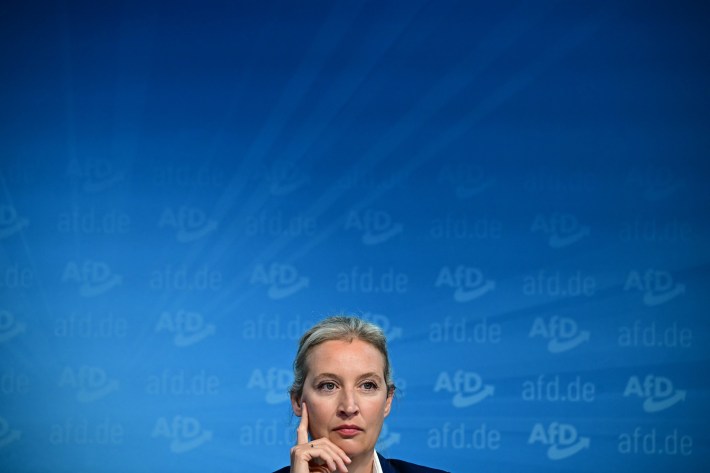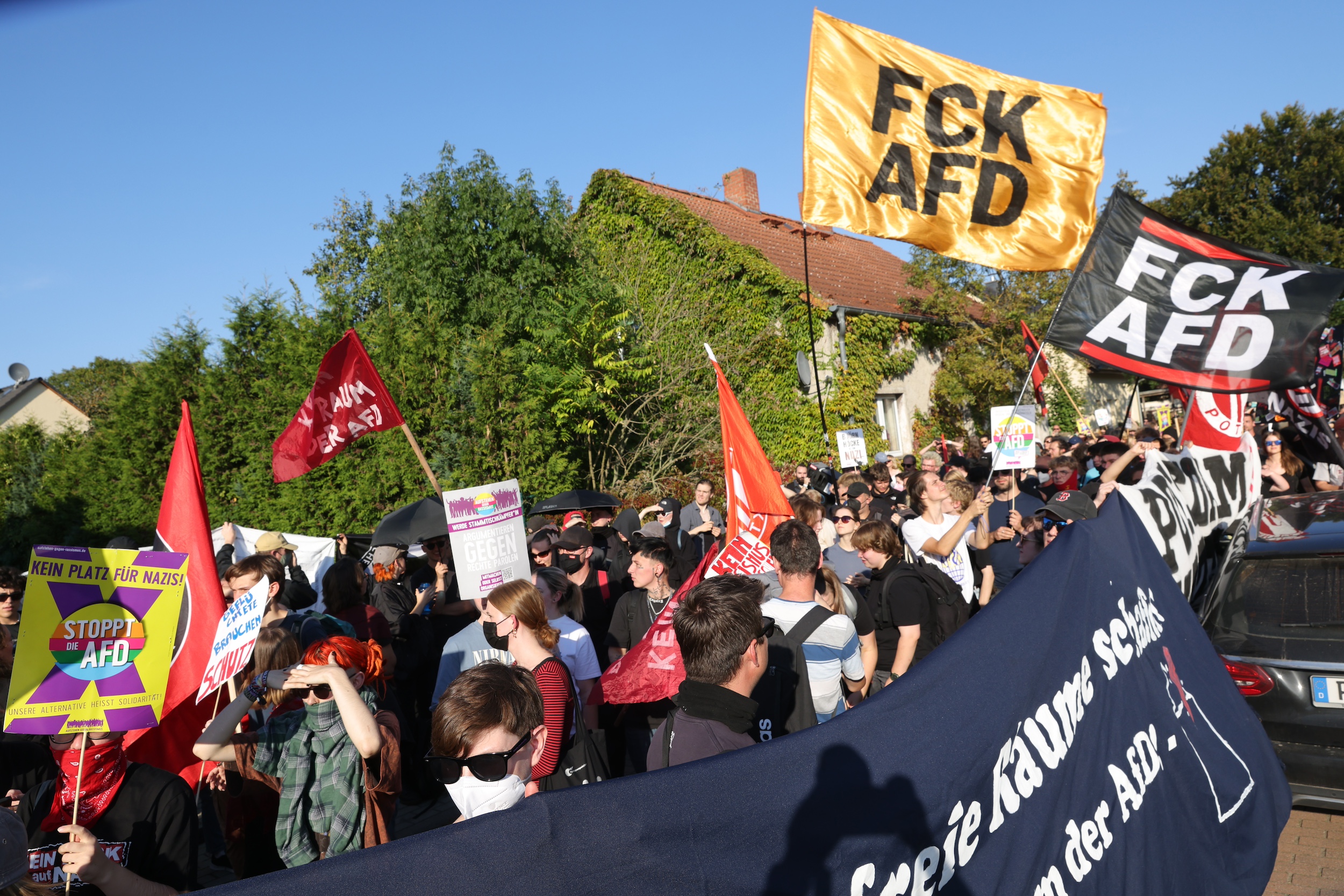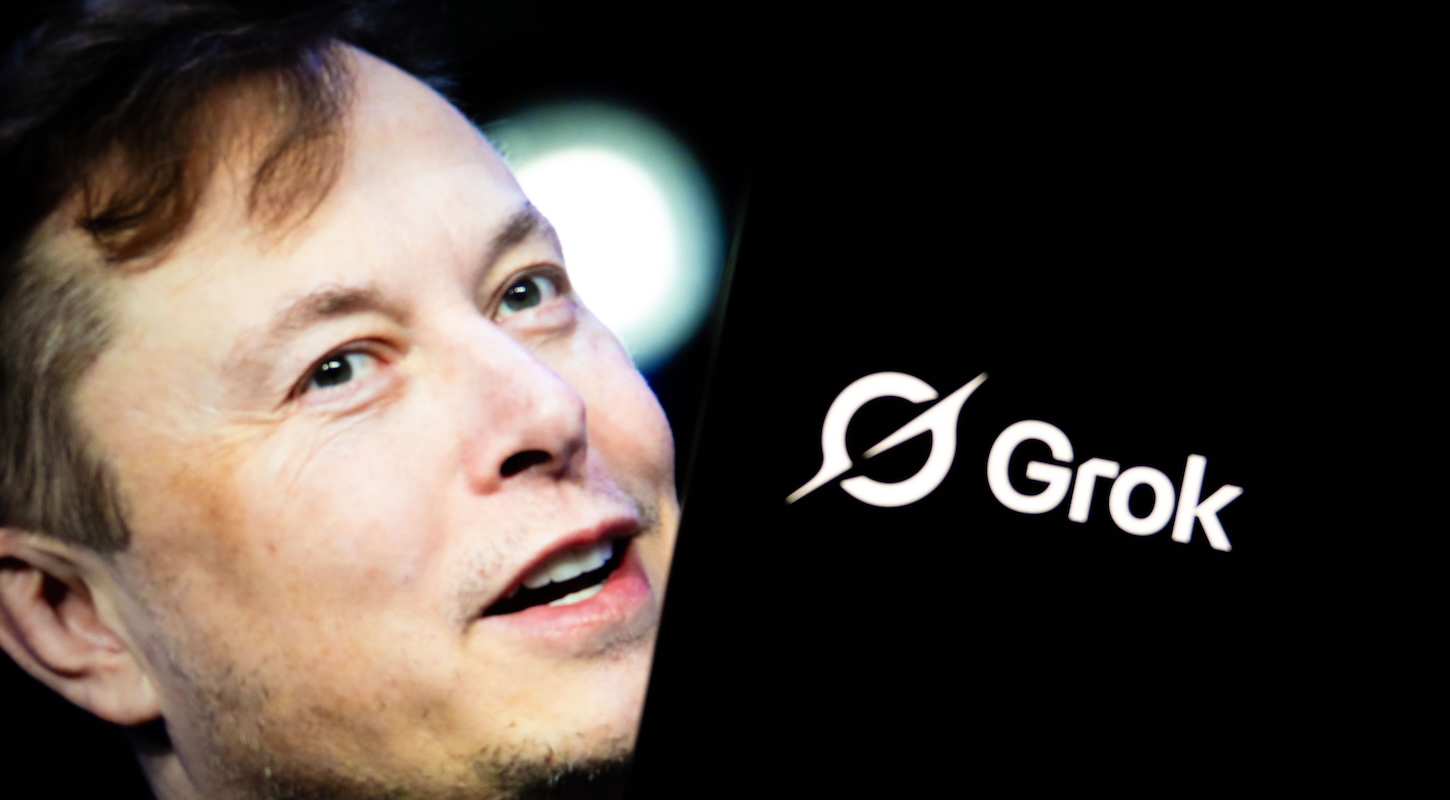On June 6, a baby-faced TikTok user named Louis, who adorns his username with two Reichskreuze—the Imperial Cross that’s often used as a neo-Nazi symbol—commented “Saxony Anhalt votes blue,” followed by a blue heart emoji, under politician Alice Weidel’s video urging people to vote AfD, the far-right Alternative for Germany party, for the 2024 EU parliamentary elections. A quick scroll down Louis’s page immediately shows two racist memes, one about Muslims and another about Black people. AfD in Saxony-Anhalt has been officially classified as an extremist group.
Weidel’s video features an anime-style cartoon of a young man excitedly voting for the AfD. A German flag flashes before the boy’s eyes, making him quiver with joy. The entire comments section is filled with blue hearts, the color of the AfD. The video ends with the hashtag “blue instead of colorful,” referring to a rejection of the “woke madness” that embraces diversity. The youthfulness and playful animation of the video may stand in stark contrast with its deeply hateful message, but its makers know exactly who they’re targeting.

Their message is resonating. It’s common to equate youth with progressive politics, to the point that the term “Boomer” has become linked with conservative attitudes and a propensity for conspiracy theories. For a long time, it was Facebook in particular that acted as a driver of misinformation, extremism, and fringe politics that began inching into actual spheres of power. But as right-wing parties across Europe and the world grow in prominence, the far-right AfD has gained significant ground in Germany among under-30-year-olds and first-time voters, and they’ve found the perfect platform to reach those voters: TikTok.
In early September, the University of Potsdam released a study that found that, among first-time voters, the AfD is twice as successful on TikTok as all other parties combined. On average, this group of voters received one video per day on TikTok that contained AfD content. Roland Verwiebe, one of the coordinators of the study, says: “From my point of view, the results are alarming because they show how the AfD […] can relatively easily reach young people who do not show a strong interest in politics on TikTok and are not explicitly interested in specific parties.”
If it took a while for the country to catch up to the fact that a not-insignificant part of the electorate was being successfully courted by the far-right, it became undeniable during three key state elections this month in Thuringia, Saxony, and Brandenburg. On Sept. 1, 35 percent of voters under 30 in Thuringia voted for the AfD, by far the strongest performance of any party in that age group. On Sept. 2, 29 percent of under-30s voted for the AfD in Saxony, with the party once again achieving a historic high. In Brandenburg this past weekend, the AfD achieved similarly strong results, garnering 32 percent among voters aged 16 to 24. Ironically enough, it was voters over the age of 70 that stopped the AfD from winning the Brandenburg elections outright, giving the Social Democrats (SPD), Chancellor Olaf Scholz’s party, the push they needed to eke out a slim lead.

So what makes a party like the AfD, which includes members such as Thuringia’s Björn Höcke who are officially classified as right-wing extremists, so popular among young people? For Dr. Rüdiger Maas, a generational studies specialist and director of the Institute for Generational Research, the answer lies, in part, with the success of the party’s message on video-forward social media platforms.
Maas explained that when he and his colleagues were conducting a study on first-time voters in Germany ahead of these state elections, he often heard statements about immigrants that expressed deep-seated mistrust—statements that weren’t rooted in facts. “They’d say things like, ‘Immigrants don’t have to pay taxes. There are asylum seekers who kidnap grandmothers and demand ransoms. I saw that on TikTok.’ It was all statements on that level. It was close to ‘Immigrants are eating dogs and cats in Springfield,’ to be honest,” he said, referencing former U.S. President Donald Trump’s lies about immigrants during the last U.S. presidential debate. “One in two people we asked said that TikTok was their main source of information.”
And what are they seeing? One user, whose name translates to “Daily Dose of Truth,” exclusively posts videos about the AfD with titles like “Alice Weidel DESTROYS arrogant journalist,” or “Alice Weidel DESTROYS puppets of the state.” Meanwhile, the TikTok account of the “Junge Alternative,” the youth wing of the AfD, which has also been classified as a right-wing extremist group by Germany’s Federal Office for the Protection of the Constitution, features dramatically filmed videos of young people leaving candles for victims of the May 2024 stabbing in Mannheim, which was carried out by a young man with Afghan roots. A young woman, whose profile displays news excerpts from the tabloid Bild about “African immigrants making the streets unsafe,” comments: “Loving your country is not fascism! Be smart and vote blue!” under the video.
For Maas, the popularity of this kind of content among younger people is the result of a perfect marriage between the AfD’s extremist content and TikTok’s propensity to promote content that is provocative, emotionally driven, and often false. Engagement is engagement, and media literacy is suffering for it.
“These extremist parties target young people and play into fears that aren’t actually based on anything real. People told us, ‘Everything is getting worse, more expensive, and more dangerous.’ And when asked to elaborate, it quickly became clear that these were fears that they had picked up on social media,” Maas explained. As an example, he brought up a video one respondent cited of someone with an immigrant background beating people up. “Well, it turns out that that video wasn’t even taken in Germany, and that it was completely taken out of context. But that doesn’t even matter anymore. Everything gets mixed up, there’s no fact-checking happening, and people are just getting bombarded with this type of content.”
It’s a familiar tale, one that we’ve all experienced after the 2016 U.S. elections and the spread of misinformation and conspiracy theories during the COVID-19 pandemic. But there’s a twist: Instead of targeting low-information middle-aged and senior voters, extremist parties have played to young voters’ mistrust of the current political establishment while also shrewdly occupying online spaces that those mainstream parties have neglected, in part because they assumed most young people would already vote more liberal anyway.
In Germany, a shift to the right among younger demographics carries uncomfortable historical echoes. In 1933, 42 percent of NSDAP members—the Nazi party—were age 30 or younger. While statistically, things are actually pretty good right now—youth unemployment in Germany is the lowest in the E.U. and the German economy is stable with a modest growth prognosis—a study about youth in Germany found that 48 percent feared poverty in old age, while fears over an increase in the refugee population (41 percent) and inflation (65 percent) also played a big role for people between 14 and 29. Young voters today have experienced a pandemic, a precarious economy, and a sense of a destabilized world order—all things that assisted the rise of the NSDAP.
Another key aspect of the AfD’s success among young people is a rejection of the right-left binary, Maas said. “[Young AfD sympathizers] told us that they don’t think the AfD is right-wing, they’re just conservative. And the fact that parties such as the Christian Democrats don’t want to collaborate with the AfD actually means the CDU isn’t really a centrist party but a more leftist one. That’s the logic: ‘There’s no centrist party.’”
This is, of course, not true, but the feeling that right and left have become ideologically meaningless labels is quite prevalent among younger voters. In fact, 26 percent of respondents to Maas’s study said that they rejected traditional “left-right” classifications. And since the AfD isn’t a right-wing party in those voters’ eyes, but instead a party that aims to address the concerns of the average German (so the logic goes), then every party that rejects the AfD is thus extremist and can be ignored. This is how the Overton window moves to the right.
The CDU, the SPD, the libertarian FDP, and even the Greens have attempted to lure some AfD voters by adopting a watered-down version of some of the party’s talking points, most notably cracking down on immigration. In October 2023, Chancellor and SPD member Olaf Scholz was featured on the cover of the weekly newsmagazine Der Spiegel, saying, “We need to be deporting on a grand scale.” The Greens have abandoned or defanged many of their asylum policies in the name of compromise for the European Union’s recent migration pact. But this tiptoeing shift to the right in an attempt to appeal to AfD sympathizers has backfired. It lends mainstream legitimacy to the AfD’s platform, and makes the more centrist parties look out of touch.
“Young voters immediately become suspicious when, for example, someone from the CDU starts making statements that sound like they come from the AfD,” Maas said. “They say, ‘Well look, the AfD has been saying that for the past five years, and the others are just now catching up. So why should I vote for someone who’s so behind?’”
The AfD’s strong presence on Gen-Z-favored social media platforms gives young voters the feeling that the party is specifically addressing them and their concerns. This cannot be underestimated where other parties have dropped the ball, Maas said. Extreme parties like the AfD also effectively create an “us versus them” narrative by promoting the so-called “underdog effect,” in which the AfD tries to position itself as the true champions of young people whose concerns have been ignored for too long. A combative approach toward journalists also plays very well online.

Although the narrative persists that the rise of the right is an East German problem, that’s not quite accurate. While the CDU—which is still a conservative party—may be polling stronger among young people in West German states, the AfD enjoys increasing popularity. In the Bavarian and Hesse state elections last year, the AfD surged to third and second place, respectively, among voters 24 and under. “The gap [between East and West] isn’t actually that big,” Maas said. “In other words, what’s happening in the East is a preview of what the West can expect.”
That’s not to say that there isn’t a divide. East Germany continues to lag behind the West when it comes to wages (although they’re catching up), and there’s a strong sense among East Germans that they’re still considered second-class citizens. However, the economic chasm between East and West is the smallest it’s ever been. But there’s also a massive demographic shift happening: More people are leaving East Germany, with more than 2 million people leaving since reunification in 1990—most of them for the West. It’s particularly women, young people, and people with immigrant backgrounds who are leaving, which strengthens the perception among those who stay that they’ve been left behind. These circumstances are fertile ground for extremist messages and emotionally driven political appeals that are built around easy scapegoats: immigrants, refugees, feminists, “the woke bubble,” the political elite—it’s a combination that works especially well within an algorithm designed to catch your attention by whatever means possible.
So what can Germans do to avoid losing more ground to the far right? First off, let’s not forget that if 32 percent of voters between 14 and 24 voted AfD in Brandenburg, it also means that 68 percent didn’t. That’s an overwhelming majority. Maas points out that 70 percent of the people he and his colleagues interviewed expressed fear over the AfD’s growing power. So while the AfD is gaining ground among young people, a majority of that demographic rejects them—this is not a case, as in the U.S., of one party in a two-party system moving hard right, and bringing its electorate with it.
“Parties that take clear positions and have a strong presence on social media currently have the best chances with young voters,” Maas said. This doesn’t mean copying the AfD’s messages or playing around with factually incorrect content, but meeting young people where they’re at and designing content that speaks directly to them, instead of at them. Perhaps that’s not quite possible for the parties that currently exist; perhaps it’s time for real alternatives to arise, alternatives that offer voters something that doesn’t rely on extremism.
Germany will hold federal elections in September 2025. The next year will go a worryingly long way toward determining if the center can hold.






